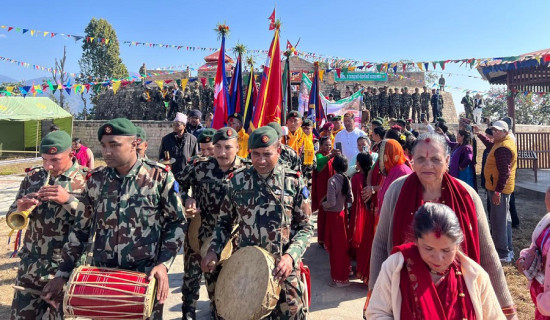- Thursday, 8 January 2026
How Dhulikhel Paved Way For Development
Development—a systematic stride for change—aims to fulfil basic needs, improve living standards, and lead a life of dignity. This buzzword resonates globally, with initiatives like the 2030 development Agenda and Millennium Development Goals not only emphasising the importance of development but also fostering cooperation across North-South and South-South regions with a message that development is a purely common agenda for every nation.
Cora defines development as progress, growth, or transformation achieved through systematic efforts across social, economic, cultural, political, personal, and technological contexts. For instance, economic development is measured by GDP growth, income levels, and employment rates. Education, health care and all other development theme must have their own progress mapping indicators.
The Sustainable Development Goals (SDGs) outline various development agendas, addressing issues like hunger, poverty, healthcare, education, climate action and disaster risk management, gender equality, and clean water and sanitation. This progress is about enhancing living standards, infrastructure, and quality of life. The rhetoric of development changed periodically and significantly over time. For instance, the current development trend refers to sustainability, resilience, and inclusivity as the preconditions under any community development initiatives undertaken. According to the SDGs or 2030 agendas, “development is to integrate contributing by one sector outcome to another, balancing social, economic and environmental sustainability”.
Leadership
Development involves statesmanship, resource mobilisation, good governance, and leadership, with governments playing a key role. However, every stakeholder, including individual citizens, has a part to play. Development is more than hollow wishes; it requires practical action with informed theoretical knowledge followed by a proper plan and monitoring framework.
Nepal's long development journey kicked off in the 1950s with various periodic plans, yet sadly progress has lagged. The country, now a federal state with three levels of governance, devolves power and resources to local and provincial governments under the 2015 Constitution, aiming for people-centred development, good governance, and human rights.
Despite significant investments, Nepal remains one of the least developed countries. A lack of strong determination, weak governance, fragile leadership, geographical challenges, rampant corruption, social discrimination, alongside a decade-long insurgency, to name some of leading factors which affect Nepal’s development process. That Nepal is scheduled to graduate from a least developed country to a developing nation in 2026 creates a discourse that Nepal is lagging behind to do enough work on the ground and it may require more time to prepare itself to be a developing country status.
However, some municipalities, like Dhulikhel Municipality, have created a successful development model with lessons extending beyond Nepal. The acquaintance of this author with Dhulikhel, located 30 km east of Kathmandu, came through attending various meetings and workshops on development. He often passed through without understanding the town's development journey until a two-day NAWB annual assembly at Hotel Sunshine, where visionary leaders like Mayor Ashok Byanjukar Shrestha and former Mayor Belprasha Shrestha (seen as the founder of Dhulikhel’s development) present as the special guests there, shared their story in the opening ceremony and other informal time.
Coincidently, the presence and remarks of Mr. Kamalraj Rupakheti, earlier representative of German Nepali Health Association who not only scrutinised hardships of people there, but also was a critical partner of the Dhulikhel development venture on behalf of his representing organisation. They detailed how the community overcame a severe water shortage that had stunted its progress for decades.
About twenty-five years ago, Dhulikhel faced significant challenges due to a lack of reliable water sources, leaving the community marginalised. Local efforts alone couldn’t provide water from distant sources. However, through Mayor Belprasha’s commitment and relentless advocacy, Dhulikhel proudly attracted financial and technical support from the Nepali and German governments, ultimately piping water from the Phulchoki River, 13 km away. This solved the water crisis and unlocked Dhulikhel’s development potential.
After securing water, Dhulikhel saw a surge in tourism in the 1990s, with hotels and resorts proliferating. The town became a favoured destination for both domestic and international tourists. The establishment of Kathmandu University, Dhulikhel hospital and other infrastructures development, including the BP and Araniko Highways, further boosted Dhulikhel’s appeal as a hub for meetings, seminars, workshops, and vacations, which expanded employment and improved livelihoods beyond Dhulikhel. Its commitment to sustainable development reached new heights further in 2021 when it endorsed fossil fuel reduction and signed a fair global energy transition treaty. It also became Nepal's first municipality to submit a Volunteer Local Review Report on SDG localisation to the UN.
Success
The municipality's success stems from unity among its people and leaders, strategic leadership, participatory planning, and pro-poor policy formulation and implementation. Civil society, political leaders, and the corporate sector collaborated, exploiting both internal and external resources to drive its economic, educational, environmental, and social development linking one sector to another area, embodying the principle of "leave no one behind". Quality foundation, healthy and environment friendly, long-term planning, and equitable opportunity and basic services for all are key cross-cutting prerequisites of building the synergy for sustainable development. Dhulikhel's development is one such endeavour. What's more, the municipality was recently declared by the WHO as the Nepal's first healthiest city and second-healthiest city in Asia, adding another feather to its cap.
Some municipalities benefit from natural abundance and strategic settings, but Dhulikhel’s advantages include natural beauty and strategic location on major highways, which connect it to Kathmandu alongside other eastern parts of the country easily. What is an interesting fact is that Dhulikhel community development succeeded in harnessing such potential for its development and prosperity. This foundation enables Dhulikhel to serve as a model for other municipalities, blending local action with a global perspective.
(The writer is a freelance consultant and inclusive development expert.)
















